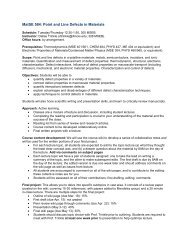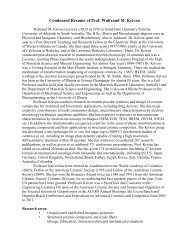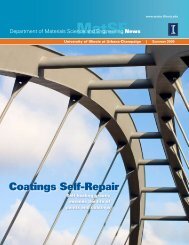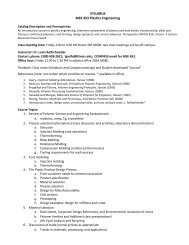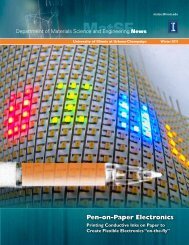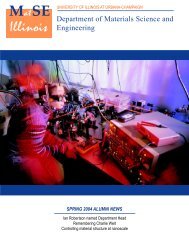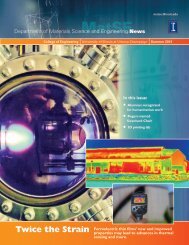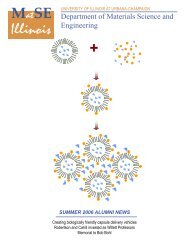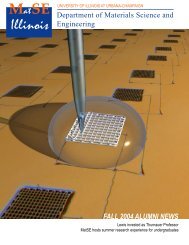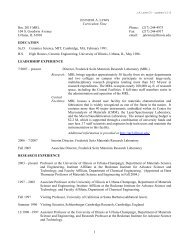Finesse with Filters - Materials Science and Engineering - University ...
Finesse with Filters - Materials Science and Engineering - University ...
Finesse with Filters - Materials Science and Engineering - University ...
You also want an ePaper? Increase the reach of your titles
YUMPU automatically turns print PDFs into web optimized ePapers that Google loves.
Controlling heat flow <strong>with</strong> atomic-level precision<br />
“The experimental methods<br />
developed here will help quantify<br />
the extent to which interfacial<br />
structural features contribute<br />
to heat flow <strong>and</strong> will be used to<br />
validate these new theories.”<br />
Through a combination of atomic-scale materials design<br />
<strong>and</strong> ultrafast measurements, researchers at the <strong>University</strong><br />
of Illinois have revealed new insights about how heat<br />
flows across an interface between two materials.<br />
The researchers demonstrated that a single layer of<br />
atoms can disrupt or enhance heat flow across an interface.<br />
Their results are published in Nature <strong>Materials</strong>.<br />
Improved control of heat exchange is a key element<br />
to enhancing the performance of current technologies<br />
such as integrated circuits <strong>and</strong> combustion engines as<br />
well as emerging technologies<br />
such as thermoelectric devices,<br />
which harvest renewable energy<br />
from waste heat. However, achieving<br />
control is hampered by an<br />
incomplete underst<strong>and</strong>ing of how<br />
heat is conducted through <strong>and</strong><br />
between materials.<br />
“Heat travels through electrically insulating material<br />
via ‘phonons,’ which are collective vibrations of<br />
atoms that travel like waves through a material,” said<br />
David Cahill, a Willett Professor <strong>and</strong> Head of <strong>Materials</strong><br />
<strong>Science</strong> <strong>and</strong> <strong>Engineering</strong> at Illinois <strong>and</strong> co-author of the<br />
paper. “Compared to our knowledge of how electricity<br />
<strong>and</strong> light travel through materials, scientists’ knowledge<br />
of heat flow is rather rudimentary.”<br />
One reason such knowledge remains elusive is<br />
the difficulty of accurately measuring temperatures,<br />
especially at small-length scales <strong>and</strong> over short time<br />
periods – the parameters that many micro <strong>and</strong> nano<br />
devices operate under.<br />
3 <strong>Materials</strong> <strong>Science</strong> <strong>and</strong> <strong>Engineering</strong> | Summer 2012<br />
Over the past decade, Cahill’s group has refined a<br />
measurement technique using very short laser pulses,<br />
lasting only one trillionth of a second, to probe heat<br />
flow accurately <strong>with</strong> nanometer-depth resolution. Cahill<br />
teamed up <strong>with</strong> Paul Braun, the Racheff Professor of<br />
<strong>Materials</strong> <strong>Science</strong> <strong>and</strong> <strong>Engineering</strong> at the U. of I. <strong>and</strong><br />
a leader in nanoscale materials synthesis, to apply the<br />
technique to underst<strong>and</strong>ing how atomic-scale features<br />
affect heat transport.<br />
“These experiments used a ‘molecular s<strong>and</strong>wich’<br />
that allowed us to manipulate <strong>and</strong> study the effect that<br />
chemistry at the interface has on heat flow, at an atomic<br />
scale,” Braun said.<br />
The researchers assembled their molecular s<strong>and</strong>wich<br />
by first depositing a single layer of molecules on a<br />
quartz surface. Next, through a technique known as<br />
transfer-printing, they placed a very thin gold film on top<br />
of these molecules. Then they applied a heat pulse to<br />
the gold layer <strong>and</strong> measured how it traveled through the<br />
s<strong>and</strong>wich to the quartz at the bottom.<br />
By adjusting just the composition of the molecules in<br />
contact <strong>with</strong> the gold layer, the group observed a change<br />
in heat transfer depending on how strongly the molecule<br />
bonded to the gold. They demonstrated that stronger<br />
bonding produced a twofold increase in heat flow.<br />
Through atomic-scale<br />
manipulation, researchers<br />
at the <strong>University</strong> of Illinois<br />
have demonstrated that a<br />
single layer of atoms can<br />
disrupt or enhance heat<br />
flow across an interface.<br />
“This variation in heat flow could be much greater<br />
in other systems,” said Mark Losego, who led this<br />
research effort as a postdoctoral scholar at Illinois <strong>and</strong><br />
is now a research professor at North Carolina State<br />
<strong>University</strong>. “If the vibrational modes for the two solids<br />
were more similar, we could expect changes of up to a<br />
factor of 10 or more.”<br />
The researchers also used their ability to systematically<br />
adjust the interfacial chemistry to dial-in a heat flow value




